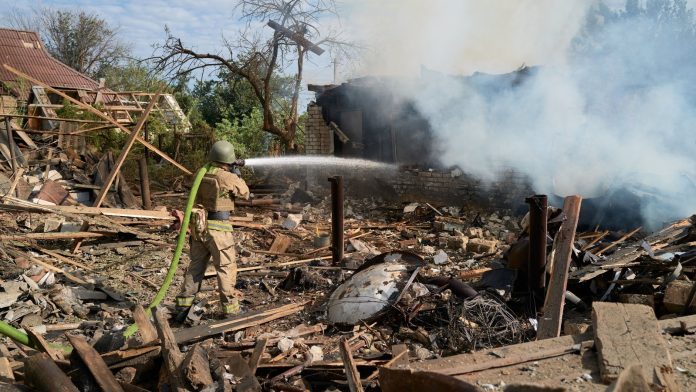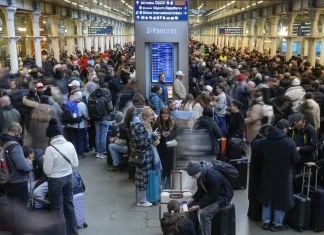
Under the Shadow of War: Ukraine’s Energy Lifeline Severed as Russia Strikes with Chilling Precision
In the quiet hours before dawn, when cities slumber and families prepare for the coming day, the hum of power plants and the glow of streetlamps are seen as constants—an invisible pulse of modern life. But in Ukraine, these lifelines have become targets under a relentless assault that threatens not only infrastructure but the very spirit of resilience.
Last night, Russian forces unleashed a devastating wave of drone strikes and missile attacks across six Ukrainian regions, leaving over 100,000 households in darkness. The energy ministry’s somber announcement revealed that critical gas transport infrastructure in the Poltava region was “significantly damaged,” while the Kharkiv, Zaporizhzhia, and Donetsk regions also sustained heavy blows. As temperatures begin to dip, these attacks strike at the heart of Ukraine’s heating supply, imperiling millions.
The Human Toll Behind the Blackout
But these attacks are more than just numbers or strategic targets—they are deeply personal tragedies. An elderly woman, 81 years old, lost her life in the overnight strike on the capital of Kherson region—an innocent caught in the cruel calculus of war. Two workers were killed at a farm there, their livelihoods and futures shattered amidst the rubble and fall of shells. This is the human cost that often escapes headlines but resounds loudly in the hearts of families and communities.
“It is not just infrastructure we are losing,” says Natalia Berezhnaya, a volunteer aid worker in Poltava. “It’s hope, warmth, safety—the things that make a house a home.”
Why Destroy Infrastructure Before Winter?
The timing of these strikes speaks volumes. Ukraine’s energy ministry accused Russia of a “deliberate policy of destroying Ukraine’s civilian infrastructure on the eve of the heating season.” The stakes couldn’t be higher. With winter approaching — and Ukraine already grappling with gas shortages after a 40% production drop earlier this year due to previous missile attacks — these new hits threaten to plunge millions into cold, dark homes.
“Heating is not a luxury here; it’s survival,” explains Vitaliy Shevchenko, an energy analyst based in Kyiv. “Every damaged pipeline or power station risks freezing entire towns. The psychological warfare is as brutal as the physical. It’s a message: endure, or break.”
Numbers That Tell a Story of Endurance and Despair
Since March 2025 alone, Ukrainian energy facilities have endured nearly 2,900 attacks, according to official data. This staggering figure reveals not just a pattern, but a campaign aimed at crippling one of the most vital sectors underpinning Ukraine’s daily life and defense.
Yet, amid this onslaught, the resilience of Ukraine’s defenders is nothing short of heroic. The Ukrainian Air Force reported downing 74 of the 95 drones launched overnight—a testament to their vigilance. Still, 21 drones managed to strike nine locations across the country, painting a stark picture of the challenges ahead.
The Wider European and Global Impact
The ripple effects of Ukraine’s crisis extend far beyond its borders. Across Europe, energy security conversations have been transformed, with nations scrambling to shore up supplies and reevaluate dependencies. The attacks set against the backdrop of diplomatic efforts—including recent attempts by global figures such as US President Donald Trump to broker peace—underscore how fragile and complex the situation remains.
“Energy infrastructure isn’t just pipes and wires,” says Dr. Anja Müller, a European security expert. “It’s about food on tables, warmth in homes, running hospitals. The repercussions echo across global energy markets and refugee flows.”
Voices from the Ground: Life in the Dark
In the northern city of Sumy, darkness blanketed neighborhoods after power lines failed. Serhii Kryvosheienko, head of the city’s military administration, paints a vivid image of the strain on utilities: “Every water utility facility is running on emergency backups. Hospitals are illuminated by generators, our people feel the cold creeping in.”
On the streets, locals share their fears and hopes. Olena, a mother of three, shares her worries: “Winter is coming, and with it, the cold. How do we keep our children safe without power? It feels like the war is in every breath we take.”
What Does This Tell Us About War in the 21st Century?
These attacks challenge traditional notions of warfare. They are reminders that modern conflicts are fought not only with guns and bombs but with strategies that cut deep into the fabric of civilian life. Infrastructure—once considered neutral or off-limits—becomes a vulnerable and deliberate target. What does this say about our collective responsibility to protect peace and the essential rights of those caught in conflict?
For global citizens, it’s an invitation to look closely at the indirect victims of war—the night without light, the winter without warmth, the lives continually disrupted by sounds of drones overhead. How do we, as a world community, respond to unseen battles fought in homes far from frontlines?
Looking Ahead: Resilience Amid Ruins
As Ukraine braces for colder days, communities find strength in unity. Volunteers repair power lines; neighbors share generators and blankets. The harsh reality is clear—these attacks are designed to erode Ukraine’s will.
Yet, amid the destruction, stories of courage bloom. “We will power through,” says Vitaliy, a volunteer electrician, tightening wires deep into the night. “Our work is small but vital—an act of defiance against the darkness.”
The resilience of Ukraine’s people is that pulsing heart that no missile, drone, or power cut can silence. For those watching and listening far away, it serves as a stark, beautiful reminder: in the face of destruction, the human spirit endures.
So as you read this, perhaps in a warm room lit softly by steady electricity, ask yourself—what would it be like to live in the dark, waiting for warmth? And how do we stand with those for whom this is the harrowing reality?









